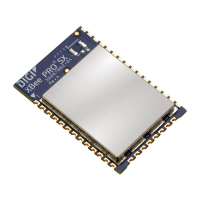Update the firmware over-the-air Verify the new application
XBee®/XBee-PRO SX RF Module User Guide
180
GPM_BLOCK_NUM GPM_START_INDEX GPM_NUM_BYTES .ebin bytes
0 0 128 0 to 127
0 128 128 128 to 255
0 256 128 256 to 383
0 384 128 384 to 511
1 0 128 512 to 639
1 128 128 640 to 767
- - - -
- - - -
- - - -
107 0 54784 to 54911
107 128 54912 to 55039
107 256 101 55040 to 55140
Verify the new application
For an uploaded application to function correctly, every single byte from the .ebin file must be properly
transferred to the GPM. To guarantee that this is the case, GPM VERIFY functions exist to ensure that
all bytes are properly in place. The FIRMWARE_VERIFY function reports whether or not the uploaded
data is valid. The FIRMWARE_VERIFY_AND_INSTALL command reports if the uploaded data is invalid. If
the data is valid, it begins installing the application. No installation takes place on invalid data.
Install the application
When the entire .ebin file is uploaded to the GPM of the target node, you can issue a FIRMWARE_
VERIFY_AND_INSTALL command. Once the target receives the command it verifies the .ebin file
loaded in the GPM. If it is valid, then the device installs the new firmware. This installation process can
take up to eight seconds. During the installation the device is unresponsive to both serial and RF
communication. To complete the installation, the target module resets. AT parameter settings which
have not been written to flash using the WR command will be lost.
Important considerations
Write all parameters with the WR command before performing a firmware update. Packet routing
information is also lost after a reset. Route discoveries are necessary for DigiMesh unicasts involving
the updated node as a source, destination, or intermediate node.
Because explicit API Tx frames can be addressed to a local node (accessible via the SPI or UART) or a
remote node (accessible over the RF port) the same process can be used to update firmware on a
device in either case.

